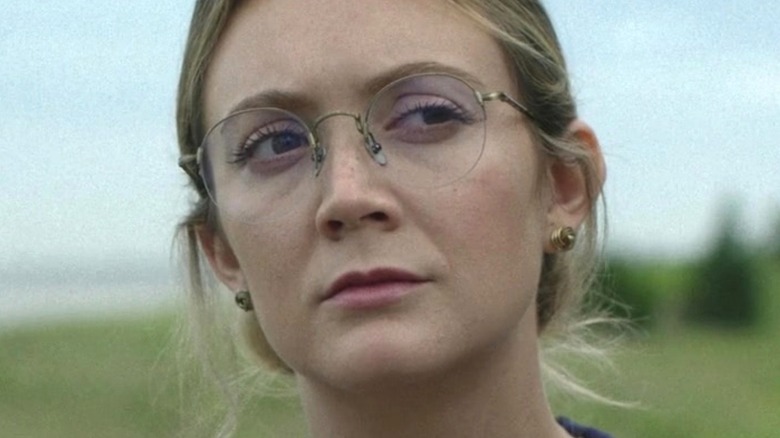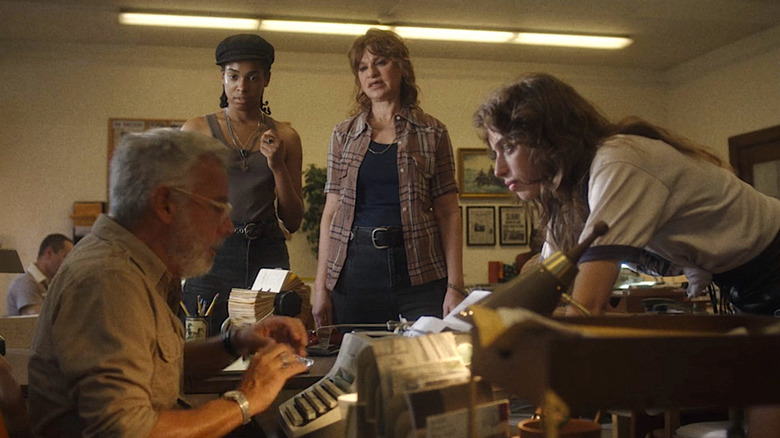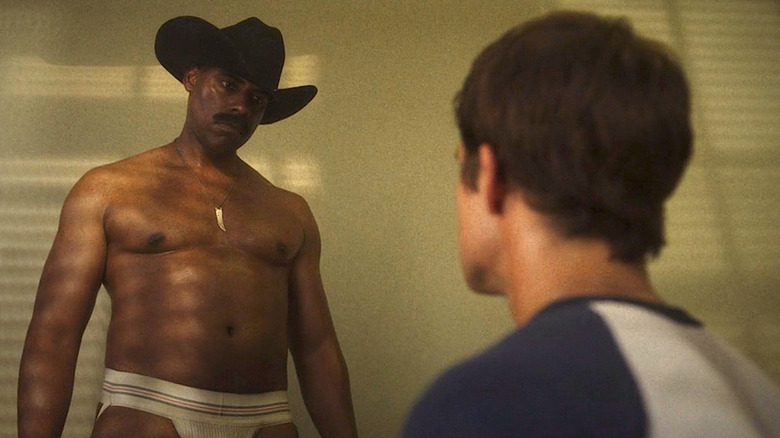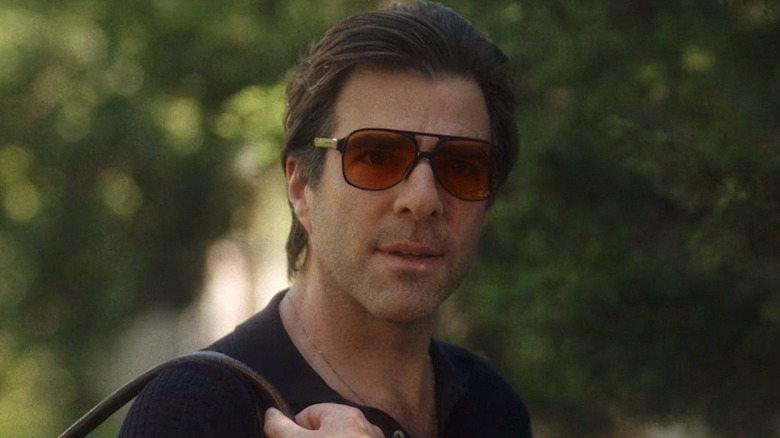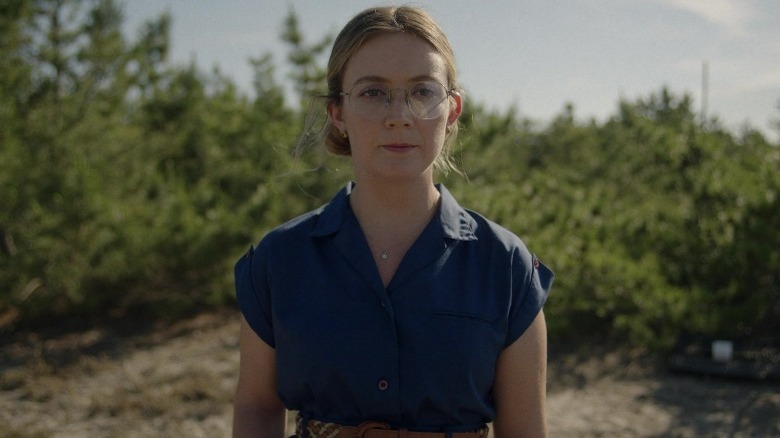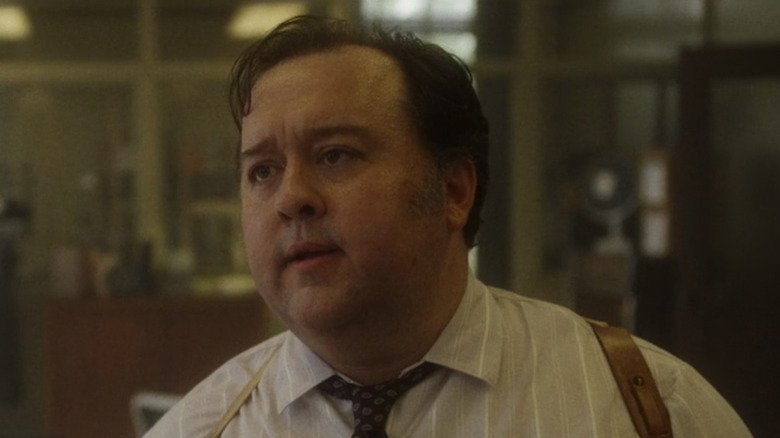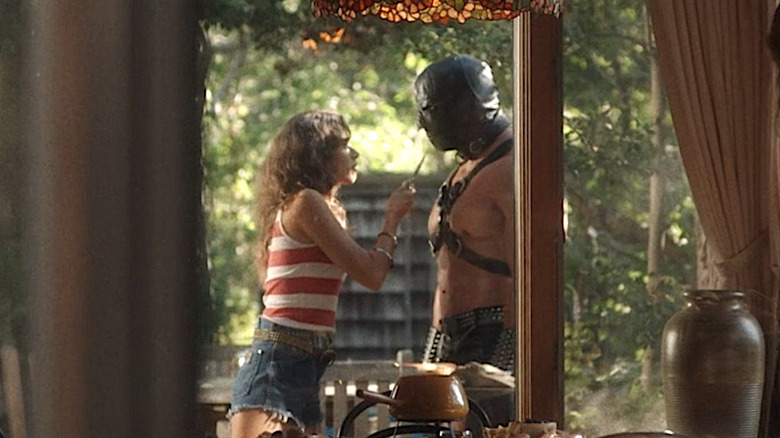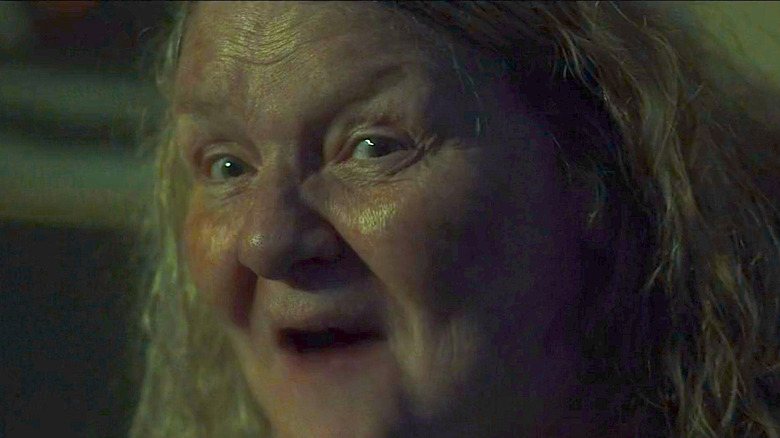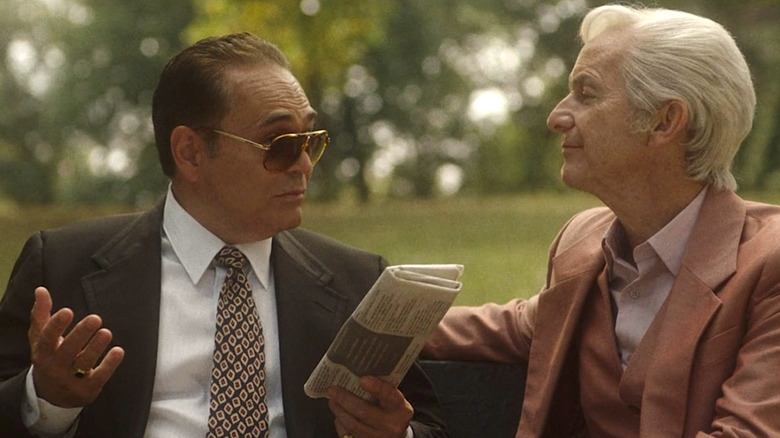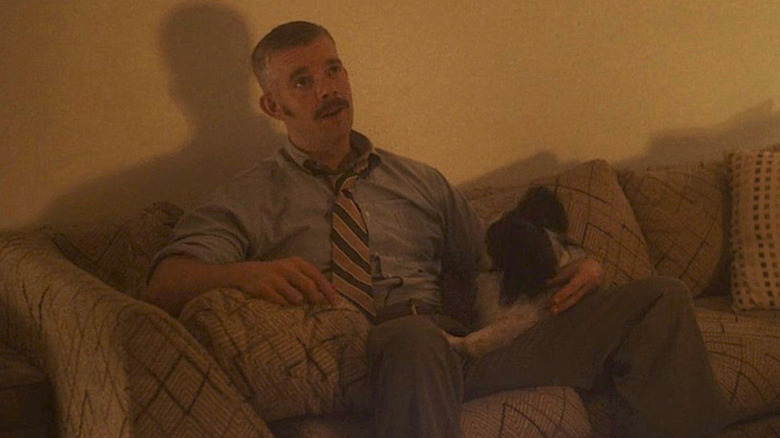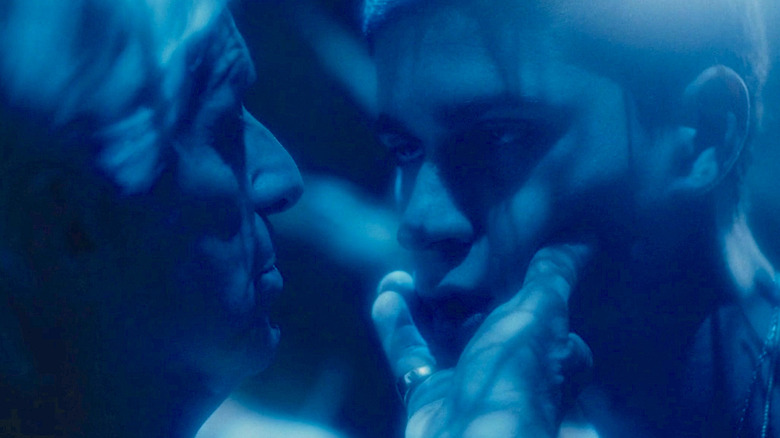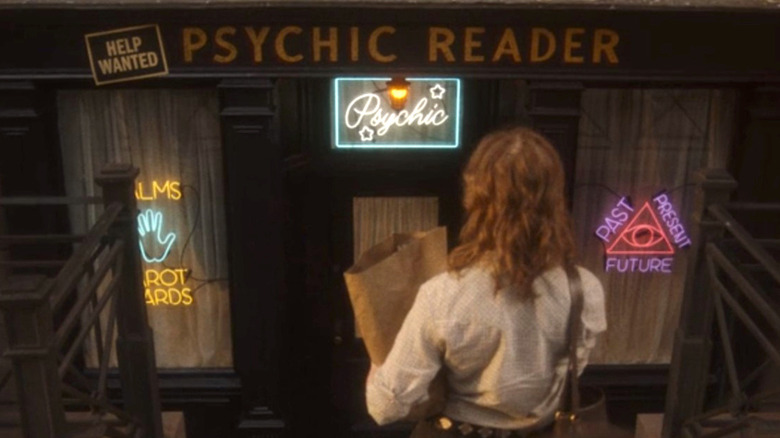Biggest Unanswered Questions From American Horror Story: NYC
"American Horror Story: NYC" is a sprawling, sorrowful serial killer story that takes place in 1981 New York. Set mostly in Greenwich Village, Fire Island, and select serial killer lairs, the show is a sometimes silly, sometimes searing exploration of what it means to protect a community — against disease, indifference, hatred, bigotry, and sometimes even against itself. Definitely against a whole bunch of serial killers.
The show plays with revising actual reality and smashing together timelines to spin a sultry, scary effect. This is a sticky, sweaty, dirty New York. Every shot is lensed with haze and horniness. The afternoon sun always seems low, and the lights are constantly on the verge of going out. The show borrows the paranoid atmosphere of the 1970s Summer of Sam to mesh with the threat of constant blackouts in the 1980s to aid its atmosphere and uses the barely pre-AIDS era to show a taste of the vitality the queer community can enjoy without shame –- for one hot second.
Then the show delves us into the depths of several interlocking mysteries and horrors, asking new questions as soon as it answers the ones that have been on our minds since the previous episode. This means that even though Season 11 of "American Horror Story" has concluded, some storylines remain unresolved. Read on to learn the biggest unanswered questions from "American Horror Story: NYC" at your own risk –- spoilers, sex, and violence abound.
What about the lesbians?
There is a moment in "American Horror Story: NYC" where Gino (Joe Mantello) is confronted in his newspaper office by a gang of rowdy lesbians demanding equal attention for their issues in the pages of The Downtown Native. Gino is happy to offer the women freelance work and the chance to write their own story but insists that since he's a gay man, he's writing about his issues in his paper. It's a moment played for tension and some laughs, but also unintentionally foreshadows the notable deletion of lesbians from the narrative of "American Horror Story: NYC" -– at least in the season's final episodes.
The show dips in and out of a disjointed storyline involving the handful of lesbians in Greenwich Village and their relationship to possible biological warfare against the queer community in the form of infected ticks. Conspiracy theories and the investigation of the ticks are almost exclusively the provinces of the lesbians in the series — when they aren't out (badly) reading tarot cards. In a way, we wonder why ticks got second billing under the deer in "American Horror Story: NYC," but not all diseased creatures can be stars.
We don't get much of a check-in with these characters when the show time jumps to later years and it's hard not to wonder what became of these women. Maybe sort-of psychic Fran (Sandra Bernhard) ended up joining other queer women who cared for people with AIDS during the epidemic's height.
What's with the Slappin' Cowboy?
It isn't exactly surprising to see a half-naked cowboy in "American Horror Story: NYC" — or really any Ryan Murphy production. In fact, if you blinked, you might have missed the moment Adam got slapped by such a cowboy in the middle of a homophobic police precinct. In a show that often uses random and extreme moments for dramatic effect, and in a season that prioritizes dream sequences and visual metaphors, let us assure you –- the Slappin' Cowboy is real, and the scene is actually a fairly direct homage to an Al Pacino movie.
"Cruising" is a 1980 movie directed by William Friedkin (of "The Exorcist" fame) about a detective who goes undercover to stop a serial killer targeting gay men in New York's S&M scene. If it sounds like this season of "American Horror Story," it should. Russell Tovey told Variety that Ryan Murphy called him up, saying, "I've got a great role for you. It's going to be based on 'Cruising' ... It's kind of like the Al Pacino role."
According to Friedkin's "Cruising" commentary (via Film School Rejects), the Slappin' Cowboy was inspired by urban legends surrounding police interrogation tactics. Apparently, if precincts used extreme measures like a half-naked cowboy, it could protect interrogators from other accusations of wrongdoing if their targets' truth sounded stranger than fiction.
Are we supposed to forgive them for Billy?
We know, there are plenty of awful murders in "American Horror Story: NYC" -– but there's only one where a twink is accidentally sexed to death in a pillory. Alas, poor Billy (Danny Kornfeld), we did not know you well –- and neither did Sam (Zachary Quinto) or Detective Patrick Read (Russell Tovey). Maybe that made it easier for them to bury the poor kid in a shallow grave made of sand, but it doesn't make it any easier for audiences to stomach.
In a show full of disturbing deaths and explorations of punishment, Billy's murder stands out. Perhaps because of how careless it was, perhaps because it began in pleasure, but in any case, it links the complicated "hero" character, Patrick Read, with craven villain Sam forever. Sam, who casually left playthings in cages for days, gives off the strong vibe he's killed on accident and on purpose before, and all before he tricked Theo (Isaac Powell) into a terrible death.
There are many murders and needless deaths "American Horror Story: NYC" confronts viewers with, but why did the careless, coke-fueled murder of an innocent fresh face feel so brushed under the rug -– or shallow sand dune -– here? Especially since the penultimate episode forces viewers to spend so much time in Sam and Patrick's heads. Are we being asked to forgive them or to understand them –- and is either possible?
What's the deal with the deer?
One thing you know about "American Horror Story" is that if deer are present, they're gonna be a big problem. The deer storyline in "American Horror Story: NYC" is as big a problem as Big Daddy (Matthew William Bishop), but unlike that gruesome brute, the deer never quite get their moment of clarity in the show. Are the deer supposed to be a horror stand-in for the chimpanzees that doctors suspected of originating the AIDS virus in real life? Were they supposed to be a striking sleight-of-hand to keep audiences guessing about what the show's "disease" actually was? Oh, deer.
Also, why is a medical doctor (for humans) like Dr. Hannah Wells studying diseased deer on Fire Island? Some attempts at explanation are made, but never enough to justify why Dr. Wells (Billie Lourd) has the power to demand a Fire Island deer culling at the beginning of the season. No explanation is made for the "sudden repopulation" of the culled deer, a detail Adam (Charlie Carver) learns when he is going through the deceased doctor's audio notes.
Deer imagery is also given priority with sweet, doomed Theo and the deer boys that usher him into his afterlife experience. Glittery and blue-toned when we meet them, the boys and men Theo photographed in life release him from pain in death while wearing glittery antlers that look like they came from a high-end Party City. Is the importance of the deer imagery in the show linked to the presence the real-life animals have on gay haven (and "American Horror Story" hell) Fire Island?
What's up with Mulcahey?
Detective Patrick Read's coworker, Mulcahey (Brian Ray Norris) strikes us as odd. Is there more than meets the eye with this character? While Patrick disparages Mulcahey to Gino at home, and we learn in the final episodes that Mulcahey witnessed Patrick's kiss (and betrayal) of his former partner, Mulcahey displays some behavior that shows he might be sympathetic to Patrick's lifestyle.
After all, when Patrick goes on record with Gino and tells all to the New York Native about catching the Mai Tai Killer, his desk is painted pink by other cops — but Mulcahey quotes some of Patrick's article and asks if Patrick is surprised he has read a gay paper. In another conversation, Mulcahey is visibly frustrated that Patrick thinks he's the one making "homophobic cracks" behind his back and comments that Patrick "thinks he has all the answers." Mulcahey also snaps at another officer who laughs at Patrick when he says Big Daddy came for him at Barbara's house.
This could simply be a nuanced performance by Brian Ray Norris, but since "American Horror Story" is not shy about hiding Easter eggs and small details referencing real life in its episodes, we wonder if this final clue seals the deal. The Mai Tai Killer draws obvious inspiration from the Last Call Killer, who had a victim named Thomas Mulcahy (via The Boston Globe). Could this be an innocent coincidence, or is using the name "Mulcahey" for this seemingly homophobic detective supposed to send a message to viewers about closeted shame and its consequences?
Big Daddy problems
"American Horror Story" isn't afraid of being audacious. The show uses a virus as a metaphor for a virus, for crying out loud. However, when it comes to Big Daddy, the leather-Daddy baddie of "American Horror Story: NYC" the metaphor is made clear in the show's final episodes -– he's the specter of HIV/AIDS. Still, the fact that this beautiful, brutal harbinger of death is a different sort of serial killer also raises a bunch of big questions.
Big Daddy stands sentinel over those living with the disease, like Gino or Sam (remember him lurking in Sam's hallways?), waiting to claim their lives. He kills when the time has come, the physical embodiment of a life lost to the terrible disease. Big Daddy as a silent force of mass destruction makes painful and poetic sense -– for about five minutes. At different points in the series, Big Daddy doesn't seem like a metaphor at all, but a man with physical mass –- he even breaks down a door in a rental! Gino eventually stabs this "metaphor" in the leg, using the switchblade Fran gave him. Patrick Read shoots it in the head. A tiny lesbian with a switchblade even scares Big Daddy off, prompting us to ask -– can a metaphor be scared?
Big Daddy also throws a molotov cocktail into the Ascension Club. Was the molotov cocktail also a metaphor? Big Daddy also makes out with Sam before sending him into the bright white light. Why does Sam get the french kiss of death while others get their neck snapped? Next time you see Big Daddy lurking in the trees, be sure to ask him.
What is up with something is coming lady?
New York City can feel like the biggest small town in the world, but in the case of "American Horror Story: NYC," it literally is. Every character crosses paths with one another on a daily basis, whether it's at the club, in the doctor's office, constantly walking past the same tarot shop, riding the Fire Island ferry, or taking the same subway car. This connection creates a tight-knit claustrophobia to the show and makes us wonder — what happened to the lady who told Adam "something evil is coming for you" at the beginning of the season and then says "I told you" at the end of the season?
What was her special fixation on Adam? Does he see her every time he rides the subway, from 1981 to 1991? Did he recruit her to help him post his "Playing rough? Use a condom" fliers? Something is Coming Lady really doesn't have a problem telling it like it is, so we hope she and Adam saved some lives by joining forces to warn the masses that something is indeed coming -– and it will change New York forever.
What's up with the mob?
It's safe to say that no one saw Henry's turn from dishy barfly to gay hitman who calls himself Velvet Touch coming. One moment, Henry (played by "American Horror Story" regular Denis O'Hare) is spilling tea and sipping cocktails at his local watering hole, and the next, he's sawing his own hand off to escape the Mai Tai Killer. While it doesn't take much for us to buy Henry as a well-connected contract killer in pastel, we do wonder what was going on with the fellas he worked for.
At several points throughout the back half of the season, Henry alerts Gino that the mob he works for wants Gino dead, or alive, or dead again. Gino even learns that mob boss DeMarco (James Ciccone) wants the ruckus Gino and Patrick are kicking up to get quiet, quickly. It's really not clear what the mob's stance on nosy gay reporters is or why they have a particular fixation on Gino. In real life, the mob helped establish NYC's gay bar scene to turn hefty profits for themselves (via History), but in "American Horror Story: NYC," the connection is unclear. However, one thing that is crystal clear is just how bad Henry has it for Gino. Talk about a killer crush.
What happened to the dog?
Look, we know the dog that Barbara (Ursula Khan) got after Patrick left her for Gino is simply a plot-device papillon. This precious pup exists seemingly solely to get Patrick back to Barabara's apartment after her collapse and hospitalization that occurs post-divorce paperwork signing. How else could Big Daddy know to stalk her or attack Patrick there?
Without this ball of fur and convenience, we would also never get to see Patrick have a rare moment of calm in the midst of yelling at Gino, coming out to his boss, reburying the body of the man he killed, or hunting for the Mai Tai Killer and Big Daddy.
Of course, now that we know Big Daddy isn't your standard-issue leather-daddy serial killer. He's spectral, or spiritual, or — you know what, we don't know for sure. The point is that Barbara is dead. Eventually, Patrick joins her. Further down the road, Gino joins him. However, one little soul's fate certainly remains uncertain –- that of the tiny pup that time and the writers of "American Horror Story: NYC" seemingly forgot.
What is the show saying about punishment?
The queer trauma of "American Horror Story: NYC" is staggering. "American Horror Story" is known for being liberal with fetish wear and bloodbaths in the name of entertainment, but this season is more harrowing than a Rubber Man or Lady Gaga slitting throats with a sequined glove. For all of the cast's sex appeal and the show's aggressive approach to putting the sexual energy of queer New York in 1981 on-screen, there is plenty of punishment laced into "American Horror Story: NYC" –- and not just the painful yet pleasurable kind explored in BDSM.
Whether it's Henry caressing a dying Theo's face while condemning him for throwing his beauty away, Daniel (Hale Appleman) screaming at the "reckless boys," or a parade of men literally or figuratively serial killed for daring to explore their sexuality -– sex feels on trial here. The verdict, for whatever it's worth, feels like it's coming back "guilty." But what does that mean?
Something curious about doing a horror show about real-life horror begs a statement to be made by the creators on that real-life horror. "American Horror Story" has a lot to say about the AIDS crisis, but the focus on punishment makes it hard to understand exactly what that is. Even Patrick Read, a hero and villain in any view, is ushered into the afterlife not by his lover but by his ex-wife. Patrick asks Barbara if she is there to punish him. She caresses his face and tells him condescendingly, "Oh, sweetheart. There's nothing left of you to punish."
What about Fran's psychic powers?
No joke, Fran from "American Horror Story: NYC" might be the worst tarot card reader ever. Despite her claim that she is "sort of psychic," Fran reads tarot cards the way Adam Carpenter reads an orgiastic room. Not well!
Still, when Fran isn't shrugging her shoulders at drawing the Death card three times in a row or giving doomed clients the "yikes" face when they draw the Death card on Fire Island, she is sort of psychic. This mostly manifests in her speaking in a scary voice one time during the "Bad Fortune" episode.
We definitely thought Fran's psychic powers would get more time in the hazy early '80s New York sun, but just like Theo being able to "sometimes" see visions, anything remotely looking like a premonition played second fiddle to serial killers this season. Still, Fran has some serious swagger, and here's hoping it served her well in her own future. Perhaps Fran used her ability to waltz into any local establishment and win a gig to good effect and became a stand-up comic — much like Sandra Bernhard did (via MovieWeb). We can totally see Fran one day making a Netflix documentary about LGBTQ+ stand-up.
